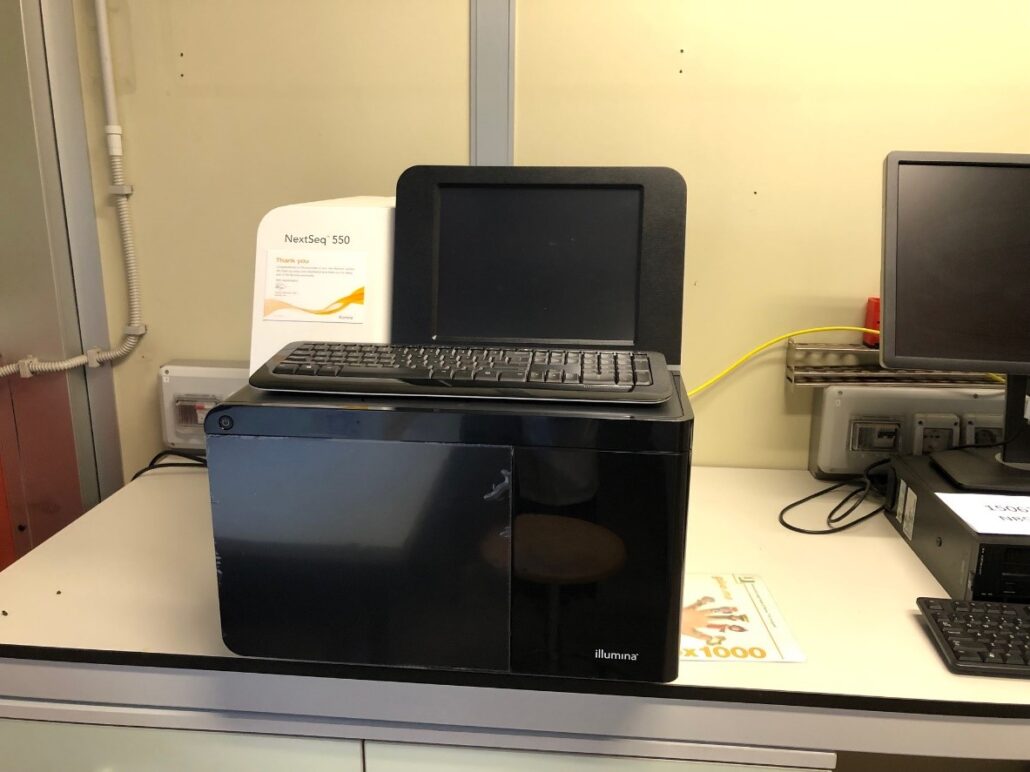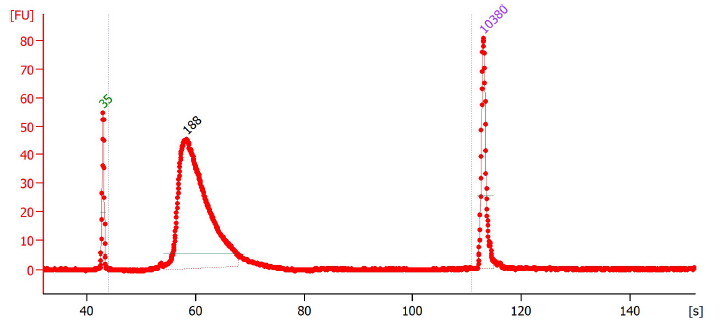The Illumina NextSeq 550 System is the only benchtop next-generation sequencing (NGS) system capable of sequencing a 30× human genome in a single run
- Exome Sequencing
- Targeted Gene Sequencing (amplicon, gene panel)
- Whole-Transcriptome Sequencing (total RNA-Seq, mRNA-Seq, gene expression profiling)
- Cytogenomic Arrays
NEXTSEQ-550 ILLUMINA
Name of the contact point
Name of the laboratory
CRISTINA MARTINEZ-LABARGA Cristina.martinez@admin
Description of the technique The NextSeq 550 System is an integrated platform that uses massively parallel sequencing technology for genetic analysis and functional genomics. Prepared libraries are loaded directly onto the system. Integrated cluster generation provides automated clonal amplification of single molecules randomly distributed on a glass surface. The DNA clusters thus obtained are sequenced on the NextSeq 550 using the Illumina sequencing-mediated synthesis (SBS) method with patented chemistry based on reversible terminators. In addition, the NextSeq 550 System combines.
| Description of the technique The NextSeq 550 System is an integrated platform that uses massively parallel sequencing technology for genetic analysis and functional genomics. Prepared libraries are loaded directly onto the system. Integrated cluster generation provides automated clonal amplification of single molecules randomly distributed on a glass surface. The DNA clusters thus obtained are sequenced on the NextSeq 550 using the Illumina sequencing-mediated synthesis (SBS) method with patented chemistry based on reversible terminators. In addition, the NextSeq 550 System combines microarray scanning with the sequencing system. The system offers: • Scalable from 20Gb to 120Gb on a single run to support a wide range of application and studio sizes • Runs, including clustering on the instrument, in 12-30 hours • Fully automated on-instrument cluster generation to prepare libraries and upload them directly to the instrument • The highest accuracy of any high-output benchtop sequencing system • Demonstrated SBS chemistry with single base extension makes accurate sequencing of homopolymers possible • Fully automated paired-end sequencing |

TECHNICAL SPECIFICATIONS The system consists of a NextSeq 550 sequencer, incorporating a flow cell and dedicated reagent configurations, to generate up to 400 million filter-passing clusters (up to 120 Gb) in High Output configuration and up to 130 million clusters passing filter (up to 40Gb) in Mid Output configuration. The system also includes an option to integrate with the BaseSpace® genomic computing environment, an easy, secure and cost-effective way to store, analyze and share genomic data available both in the cloud and in the laboratory (system BaseSpace Onsite).
AVAILABLE TECHNIQUES
• Resequencing of the whole genome
• Targeted resequencing includes, but is not limited to, the following methods:
• Exomes (37 Mb-62 Mb)
• Custom enrichment panels (100 kb-Mb)
• Custom amplicon panels (100 kb)
• De novo sequencing
• Mate-pair sequencing for libraries with 2-5 kb insert sizes
• ChIP sequencing of sequence-specific DNA binding proteins
• ChIP sequencing of histone modifications and epigenetic signals
• Sequencing of bisulfite treated DNA to study DNA methylation
• mRNA sequencing
• Marker-based gene expression
• Small RNA sequencing
• Total RNA sequencing (coding + non-coding)
• Target RNA sequencing
• Ribosomal profile
• Typing based on the HLA sequence
• Mapping of sites hypersensitive to DNAse 1
• Studies on the structure of chromatin and on the positioning of nucleosomes
• ChIP sequencing: study of the interactions of specific RNA/protein sequences
• CNV Sequencing: A measure of copy number change with sequencing
• GRO sequencing: study of RNA polymerase priming events
• Paired-end mRNA sequencing to study gene fusions in cancer
• Prenatal screening from maternal blood
• Sequencing of ancient DNA samples
• Specific expression of alleles and DNA fingerprinting
SAMPLE
DNA or RNA libraries:
Ready-to-use library preparation kits are available for:
• DNA sequencing (unidirectional or paired-end and mate-pair reads)
• RNA sequencing [total RNA strand, mRNA strand and short RNA (micro RNA)]
• Targeted sequencing (human exome, cancer panels, custom enrichment, custom amplicons)
• ChIP sequencing
USE FOR
Sequencing of prokaryotic and eukaryotic genomes, microbiome reconstruction of ancient human biological samples in the context of molecular archaeobiology, analysis of exomes, transcriptomes and non-coding RNA, gene expression, detection of pathogens and methylation analyses, epigenomic, the metagenomic analysis in the environmental, biomedical and agri-food sectors.
Case study 1 In this study genomic libraries from two human bone samples were sequenced in order to identify the sex of a pre-Roman individual from the site of Monte Piceno, as requested by Dr. Achim Weidig. The sex was identified as male after aligning the reads to the sex chromosome.
Case study 2
In this study genomic libraries from 21 archaeological cat samples were sequenced in order to screen the degree of DNA preservation in the samples. ERC project Felix (P.I. prof. C. Ottoni)

